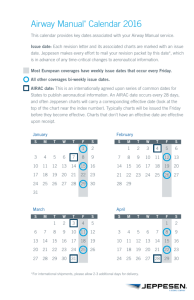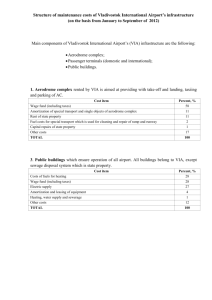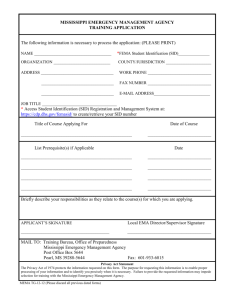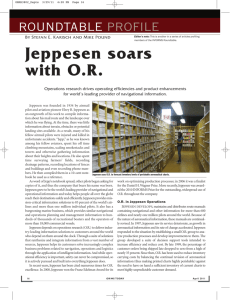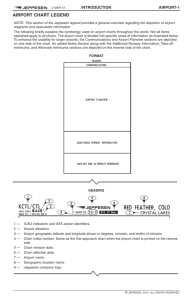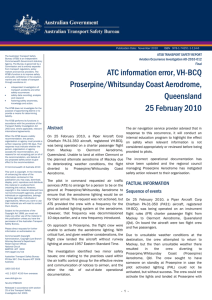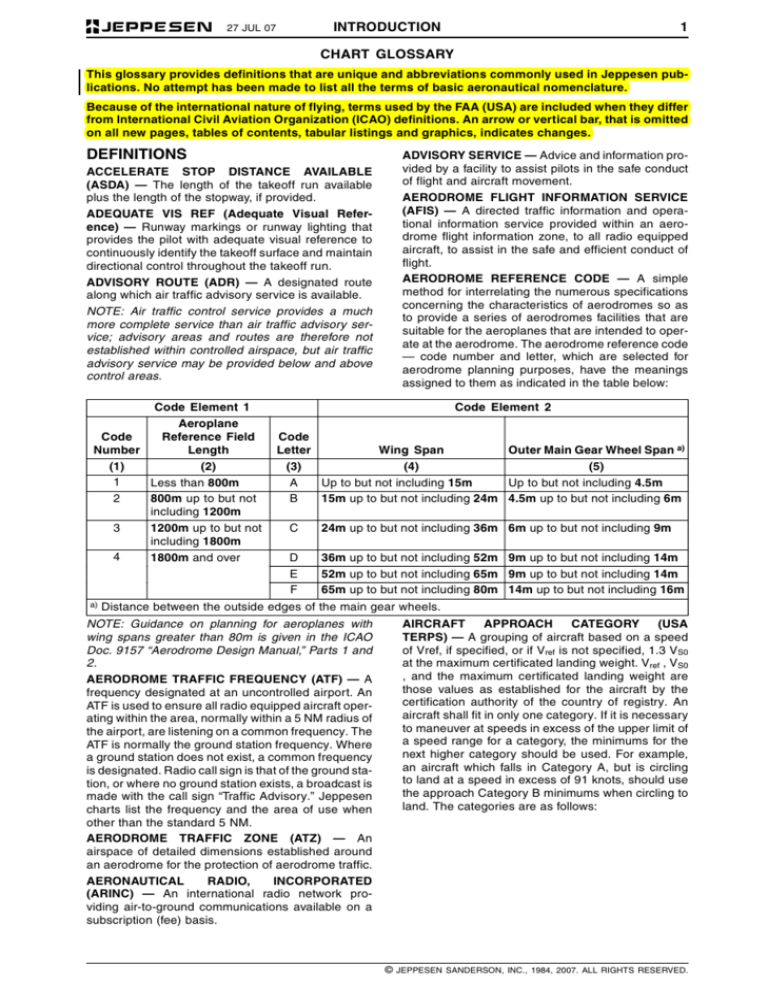
INTRODUCTION
27 JUL 07
1
CHART GLOSSARY
This glossary provides definitions that are unique and abbreviations commonly used in Jeppesen publications. No attempt has been made to list all the terms of basic aeronautical nomenclature.
Because of the international nature of flying, terms used by the FAA (USA) are included when they differ
from International Civil Aviation Organization (ICAO) definitions. An arrow or vertical bar, that is omitted
on all new pages, tables of contents, tabular listings and graphics, indicates changes.
DEFINITIONS
ACCELERATE STOP DISTANCE AVAILABLE
(ASDA) — The length of the takeoff run available
plus the length of the stopway, if provided.
ADEQUATE VIS REF (Adequate Visual Reference) — Runway markings or runway lighting that
provides the pilot with adequate visual reference to
continuously identify the takeoff surface and maintain
directional control throughout the takeoff run.
ADVISORY ROUTE (ADR) — A designated route
along which air traffic advisory service is available.
NOTE: Air traffic control service provides a much
more complete service than air traffic advisory service; advisory areas and routes are therefore not
established within controlled airspace, but air traffic
advisory service may be provided below and above
control areas.
Code Element 1
Aeroplane
Code
Reference Field
Number
Length
(1)
(2)
1
Less than 800m
2
800m up to but not
including 1200m
3
1200m up to but not
including 1800m
4
1800m and over
a)
ADVISORY SERVICE — Advice and information provided by a facility to assist pilots in the safe conduct
of flight and aircraft movement.
AERODROME FLIGHT INFORMATION SERVICE
(AFIS) — A directed traffic information and operational information service provided within an aerodrome flight information zone, to all radio equipped
aircraft, to assist in the safe and efficient conduct of
flight.
AERODROME REFERENCE CODE — A simple
method for interrelating the numerous specifications
concerning the characteristics of aerodromes so as
to provide a series of aerodromes facilities that are
suitable for the aeroplanes that are intended to operate at the aerodrome. The aerodrome reference code
— code number and letter, which are selected for
aerodrome planning purposes, have the meanings
assigned to them as indicated in the table below:
Code Element 2
Code
Letter
Wing Span
Outer Main Gear Wheel Span a)
(3)
(4)
(5)
A
Up to but not including 15m
Up to but not including 4.5m
B
15m up to but not including 24m 4.5m up to but not including 6m
C
D
E
F
Distance between the outside edges of
24m up to but not including 36m 6m up to but not including 9m
36m up to but not including 52m 9m up to but not including 14m
52m up to but not including 65m 9m up to but not including 14m
65m up to but not including 80m 14m up to but not including 16m
the main gear wheels.
NOTE: Guidance on planning for aeroplanes with
wing spans greater than 80m is given in the ICAO
Doc. 9157 “Aerodrome Design Manual,” Parts 1 and
2.
AERODROME TRAFFIC FREQUENCY (ATF) — A
frequency designated at an uncontrolled airport. An
ATF is used to ensure all radio equipped aircraft operating within the area, normally within a 5 NM radius of
the airport, are listening on a common frequency. The
ATF is normally the ground station frequency. Where
a ground station does not exist, a common frequency
is designated. Radio call sign is that of the ground station, or where no ground station exists, a broadcast is
made with the call sign “Traffic Advisory.” Jeppesen
charts list the frequency and the area of use when
other than the standard 5 NM.
AERODROME TRAFFIC ZONE (ATZ) — An
airspace of detailed dimensions established around
an aerodrome for the protection of aerodrome traffic.
AERONAUTICAL
RADIO,
INCORPORATED
(ARINC) — An international radio network providing air-to-ground communications available on a
subscription (fee) basis.
AIRCRAFT
APPROACH
CATEGORY
(USA
TERPS) — A grouping of aircraft based on a speed
of Vref, if specified, or if Vref is not specified, 1.3 VS0
at the maximum certificated landing weight. Vref , VS0
, and the maximum certificated landing weight are
those values as established for the aircraft by the
certification authority of the country of registry. An
aircraft shall fit in only one category. If it is necessary
to maneuver at speeds in excess of the upper limit of
a speed range for a category, the minimums for the
next higher category should be used. For example,
an aircraft which falls in Category A, but is circling
to land at a speed in excess of 91 knots, should use
the approach Category B minimums when circling to
land. The categories are as follows:
q$z
© JEPPESEN SANDERSON, INC., 1984, 2007. ALL RIGHTS RESERVED.
INTRODUCTION
16 AUG 02
NEW FORMAT 7
SID/DP&STAR CHART LEGEND NEW FORMAT
Effective 16 August 2002
IMPORTANT NOTE
Legend pages titled “NEW FORMAT SID/DP/STAR” contain information specific to charts formatted in the
new SID/DP/STAR chart concept. These legend pages include only those items that are unique to the
NEW SID/DP/STAR FORMAT. For information not covered in the NEW FORMAT SID/DP/STAR chart
legend, refer to the regular SID/DP/STAR chart legend pages in the Airway Manual.
SID/DP& STAR charts are graphic illustrations of the procedures prescribed by the governing authority. A text
description may be provided, in addition to the graphic, when it is furnished by the governing authority. Not all
items apply to all charts.
SID/DP/STAR CHART HEADING
SID/DP/STAR chart heading consists of the following:
City/Location
.
and State/Country names.
Chart type identifier.
Jeppesen
.
NavData/ICAO/IATA airport identifier.
Airport name.
Revision date, index number and effective date.
Communication frequency.
Airport elevation.
Common placement of notes applicable to the
procedure.
SID/DP/STAR CHART PLAN VIEW
PROCEDURE TITLE
Navaids, intersections or waypoints identified in the procedure title (e.g., starting point of a STAR or end point
of a SID/DP) are shown prominently for better identification. Navaid boxes will include a shadowed outline,
intersection or waypoint names will be shown in larger text size.
Navaid
Intersection
DINKELSBUL
Departure
SKEBR ONE
Arrival
SPEED RESTRICTIONS
Speed restrictions that apply to the entire procedure are shown below the procedure title.
SYMBOLS
RADIALS
VOR Radials forming a position or fix. VOR Radials are
bearings from the Navaid.
NDB bearings are to the
Navaid.
AIRPORTS
Civil or Joint use Airport
Airport with rotating beacon
Military Airport
© JEPPESEN SANDERSON, INC., 2002. ALL RIGHTS RESERVED.
INTRODUCTION
22 JUN 01
201
Nav2001
AERONAUTICAL INFORMATION NAVDATA DATABASE AND CHARTS
PROVIDED FOR USERS OF JEPPESEN NAVDATA SERVICES
PREFACE
The purpose in providing the information contained in these pages is to highlight the major differences between Jeppesen’s NavData database and Jeppesen’s Enroute, Area, SID, DP,
STAR, Approach, and Airport Charts.
Airways, departure procedures, arrival procedures, instrument approach procedures, and
other aeronautical information is designed and created by more than 220 countries around
the world. The information created by them is designed according to ICAO PANS OPS in
most countries and according to the United States Standard for Terminal Instrument Procedures (TERPs) for the U.S. and many of the other countries.
The basic design for most aeronautical information contained in instrument procedures has
been created for the analog world. The art of entering data into an aeronautical database is
one that balances the intent of the original procedure designer and the requirements of FMS
and GPS systems that require airborne databases.
All of the illustrations in this paper are from Jeppesen’s library and are copyrighted by Jeppesen. The paper will highlight differences that will be found in the charts and databases produced by all the suppliers.
Virtually all the aeronautical databases are loaded according to the specifications in the Aeronautical Radio, Incorporated (ARINC) 424 standard "Navigation Databases." While the
ARINC 424 specification covers a large percentage of the aeronautical requirements, it is
impossible to write a specification that covers every combination of factors used to design
and fly instrument procedures. Many of the differences between charts and databases are
because there can be no standard implemented to have the information in both places
depicted the same. There are some cases where it is desirable not to have the information
the same because of the different type of media where the information is displayed.
Any attempt to detail the many minor differences, which may arise under isolated cases,
would unduly complicate this overview. Therefore, the information provided is an overview
only, and only major differences are included.
There are many different types of avionics equipment utilizing the Jeppesen NavData database. The same database information may be presented differently on different types of airborne equipment. In addition, some equipment may be limited to specific types of database
information, omitting other database information. Pilots should check their Operating Handbooks for details of operation and information presentation. A major factor in "apparent" differences between database and charts may be due to the avionics equipment utilized. As
avionics equipment evolves, the newer systems will be more compatible with charts, however
the older systems will still continue with apparent differences.
Due to the continuing evolution caused by aeronautical information changes affecting both
database and charting, items described herein are subject to change on a continual basis.
This document may be revised for significant changes to help ensure interested database
users are made aware of major changes.
A brief Glossary/Abbreviations of terms used is provided at the end of this document.
©JEPPESEN SANDERSON, INC., 2001. ALL RIGHTS RESERVED.

